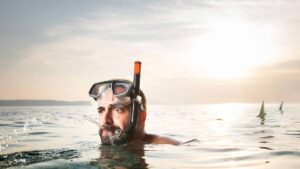When it comes to scuba diving, snorkeling, surfing, paddleboarding, and the like, divers need a quality exposure suit.
If you’re new to watersports, you might not be familiar with all of the different styles to pick from.
If you’ll be in cold water, an exposure suit is a must.
Keep reading to learn about dive skins, wetsuits, and drysuits, and which is best for you.
Contents
What is an Exposure Suit?
An exposure suit is a type of garment worn by divers before entering the water for a long time.
Different suits fit various scenarios, such as whether the water is slightly warmer or extremely cold.
Additional factors that divers must consider are their movement in the water.
Go for a warmer suit if you won’t be moving around much in the water because staying still for too long makes you colder.
Or, if you have sensitive skin and you feel colder than others at the sand temperature, you’ll want a thicker suit with mote insulation.
There are numerous brands and styles of suits available, all of which go under the category of dive suits, drysuits, and wetsuits.
Editor’s Note
If I start diving in a location, after a few dives I can always change into board shorts if my exposure suit gets too hot.
But.. if I don’t have an exposure suit and I get cold, I might have to scrub a dive.
That’s not an option for me since I don’t like to miss a dive, so I almost always err on the side of caution and wear an exposure suit.
Why Divers Wear Exposure Suits
The number one function of an exposure suit is to keep the diver warm while in cold water.
Therefore, when someone chooses an exposure suit, the top consideration is the water temperature.
It won’t matter much how great the visibility is if you can’t enjoy the sight because you’re freezing.
Heat gets carried away from the body when you’re in an environment that’s colder than your regular body temperature.
This factor isn’t much of a problem on land.
The body maintains its temperature by making more heat quickly enough to offset the loss.
Water, on the other hand, pulls heat away from the body 25 times faster than air.
Therefore, without any protection, it’s easy to get hypothermia in cold water.
Types of Exposure Suits
There are different types of exposure suits, and they come in various styles and materials.
Each are manufactured for a different reason, and come with their own unique benefits and use case.
1. Dive Skins/Rash Guards
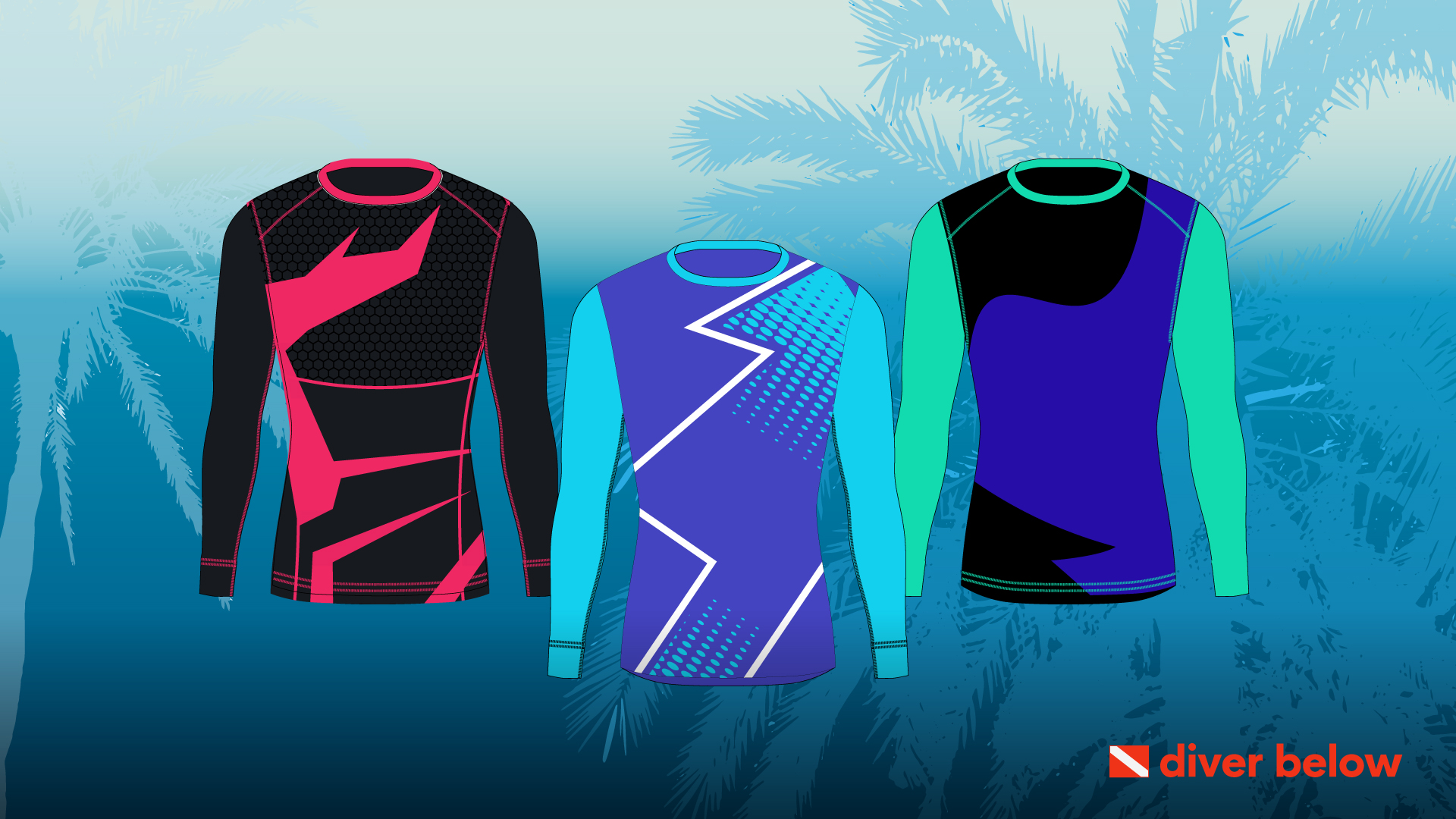
Dive skins are bodysuits that offer a thin layer of protection for the skin.
They protect the body from cuts, abrasions, stings, scrapes, and also the sun.
The material is usually a blend of spandex and Lycra.
It’s a good idea to wear a diving skin beneath the wetsuit for even more insulation.
Divers can also wear them alone if they don’t need much protection in the water.
You may sometimes hear a dive skin referred to as a rash guard.
They can be short-sleeved or long-sleeved, loose or tight.
A rashguard helps prevent skin irritation when putting on the wetsuit, and when moving around a lot in the water.
Suggested Resource
Best Rash Guards: a hand-curated list of the best rash guards for divers and swimmers
2. Wetsuits
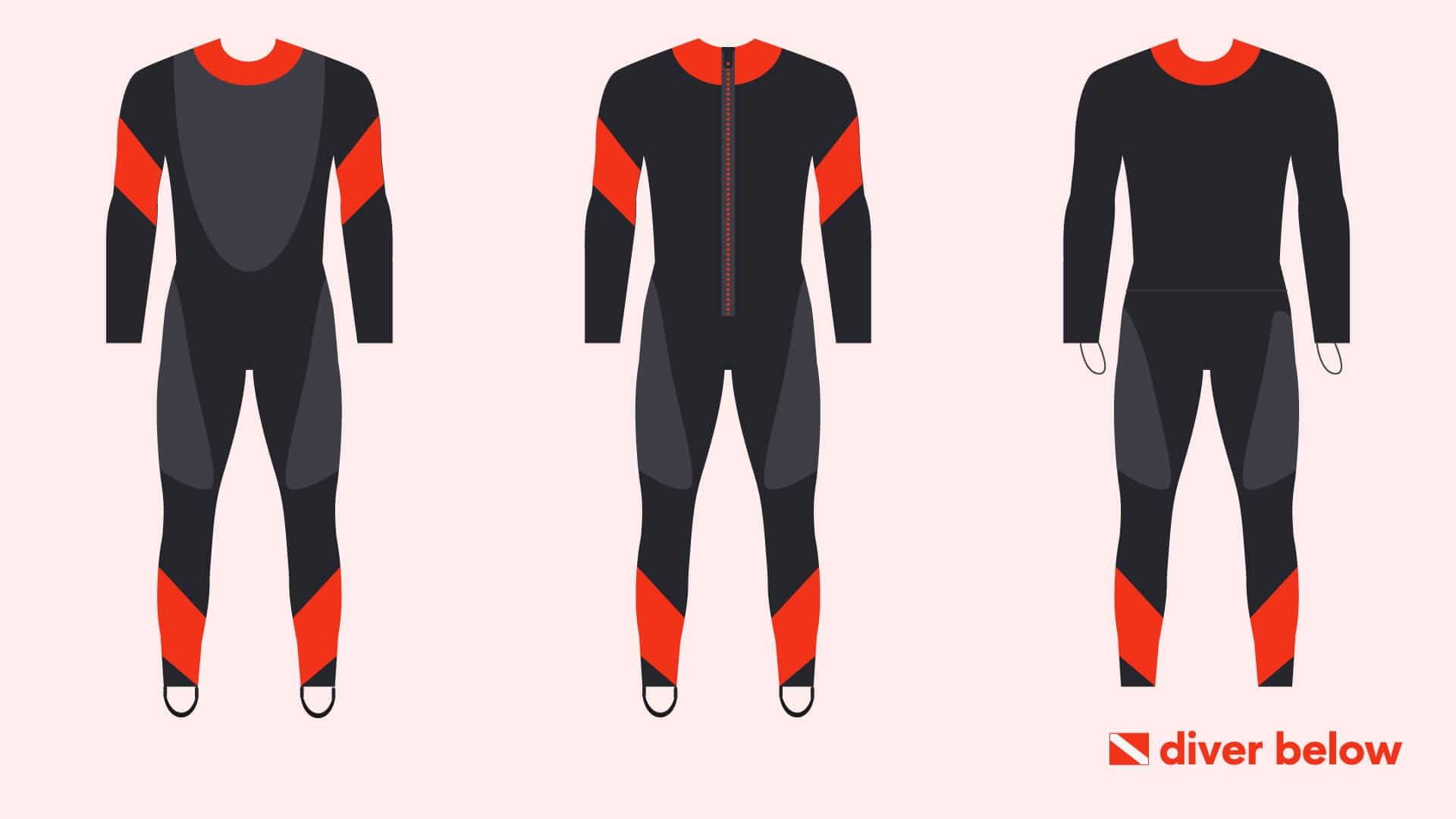
The most well-known exposure suit is the wetsuit.
Wetsuit styles are versatile, and they don’t cost as much as some in other models of exposure suits.
Wetsuits consist of neoprene, which is synthetic foam rubber.
There are gas bubbles inside of the neoprene, which traps body heat and helps to heat the water that enters the first layer of the suit.
The majority of wetsuits also have nylon or polyester lining on the inside and outside.
This fabric makes it easier to slide on and off easier and protects the neoprene from getting torn easily.
Suggested Resource
Best Wetsuits: a hand-curated list of the best wetsuits for divers
3. Drysuits
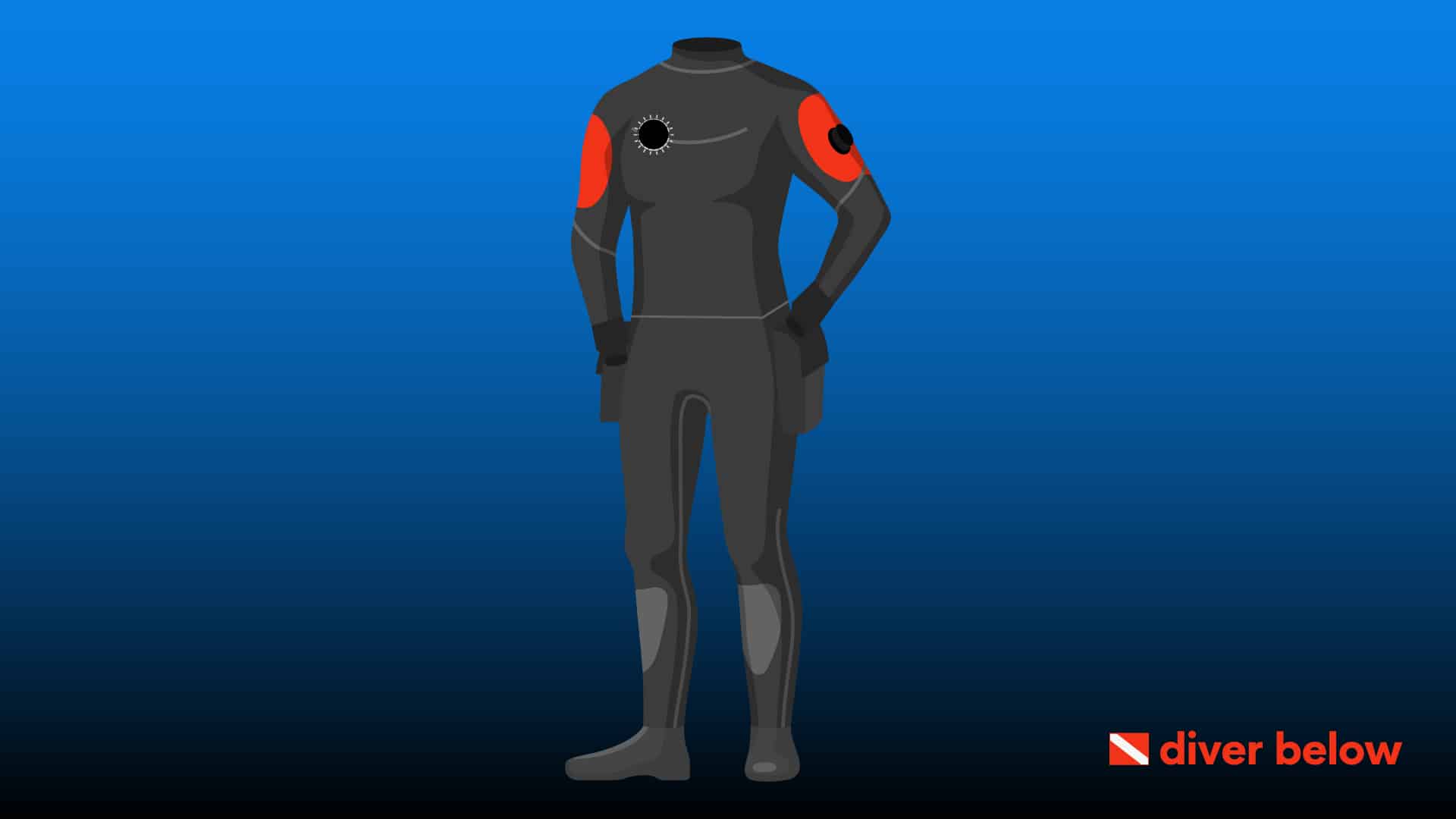
The warmest type of exposure suit is the drysuit.
A dry suit is waterproof and uses seals around the neck and wrists to stop water from entering.
It also has an airtight and waterproof zipper for entry.
The typical dry suit consists of nylon and rubber, and they’re referred to as shell suits.
It’s lightweight and thin, and it doesn’t aim to keep you warm.
If the diver needs to use a dry suit and they will be in cold water, add extra garments underneath.
You can take away or add layers to your liking if you dive with a dry suit, depending on the water temperature.
Drysuits also come in neoprene, and this style is similar to wetsuits.
No additional layers are necessary under the neoprene drysuit.
Note that the drysuit keeps a pocket of air around the body.
Air compresses when divers go down, which is why you have to add more air to the suit so it doesn’t squeeze the diver while they go down.
You need an inflation valve to add the air, which then expands as the diver goes up.
This air needs to get vented, or the diver becomes too buoyant and the ascent becomes uncontrollable.
Styles of Wetsuits
Here are the three main styles of wetsuits.
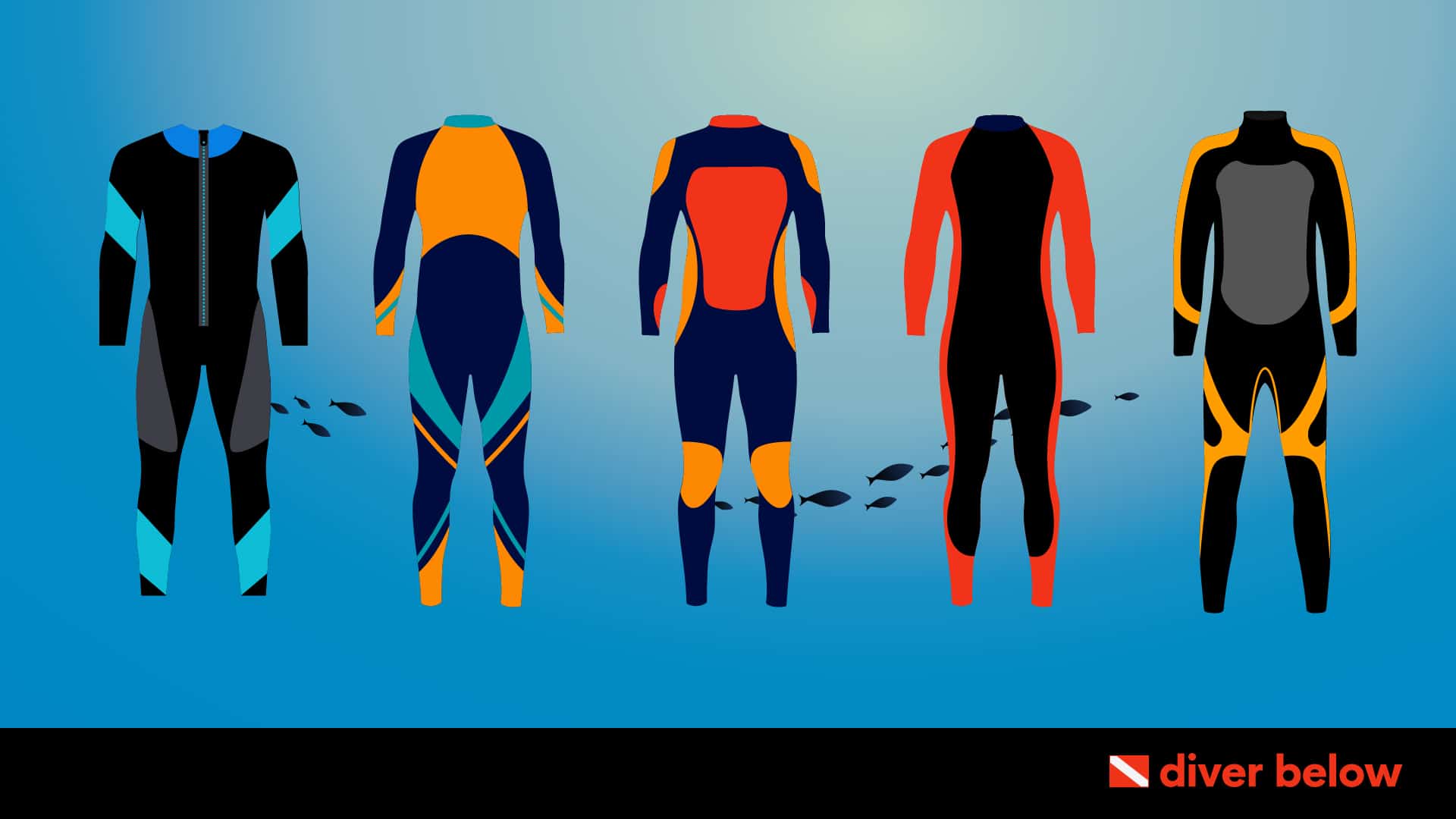
1. One-Piece Wetsuit
The most popular option is the one-piece west suit.
Perfect for scuba divers, it’s a full-body suit that stops at the ankles and the wrists.
Typically, it’s constructed of neoprene, which is a strong insulator.
These are more durable because they cover your whole body.
The primary reason to get full suits is so beneficial is that it’s flexible and lightweight.
It’s a lot easier to get in and out of as well.
2. Shorty Wetsuit
The shorty wetsuit doesn’t fully cover the body.
It exposes the legs and arms and the neoprene material is thinner, and it keeps your body at the perfect temperature on warmer days.
Shorties are stretchy and lightweight, they provide UV protection and keep the wind chill at bay as well.
These are sometimes called a farmer Jane or a farmer John suit.
3. 2-Piece Wetsuit
A two-piece wetsuit is two separate pieces that make up the wetsuit.
The bottom piece covers the diver’s torso and their legs down to the ankles.
The top piece of the suit is the midsection down to the wrists.
The best part of this suit is the insulation.
There is additional insulation encompassing the torso, and it is warmer than wearing just one piece.
It is, however, bulkier, and it doesn’t allow as much mobility.
It’s also harder to put on and take off.
Sizing an Exposure Suit
Getting the sizing correct on an exposure suit is critical to staying warm or cool during a dive.
Rash Guards
They should fit close to the diver’s body, much like a second skin.
They help to prevent skin irritation through running and chafing.
The rash guards also come in a more loose style, and short sleeves, long sleeves, and tanks.
Wetsuits
Wetsuits should not have any space between the suit and your body.
It should be tight but not restricting.
Make sure there aren’t any gaps or rolls around the lower back or torso.
Drysuits
The dry suit should fit snugly, but you should still have room to wear clothes underneath for better insulation.
That helps you to move more freely while you’re wearing the drysuit.
Remember not to wear too many layers under the drysuit, as this could restrict your movements.
Wetsuit Accessories
These are the most common wetsuit gear and accessories:
Hood
A person’s body loses a lot of heat through their head and feet.
A hood is a necessity when you dive in cold water.
The neoprene material provides excellent warmth and coverage.
You can also get the hood in several styles, and many have a bin piece that you can tuck beneath the wetsuit.
It protects your neck from getting wet, and it keeps water out of the wetsuit.
If you want even more insulation around your torso, go for the hooded vest which should get worn under the wetsuit.
These vests are ideal for one-pieces.
Your hood should be comfortable, and it shouldn’t restrict your neck movement or make it hard to breathe.
Gloves
The dive gloves come in nylon, cotton, leather, or neoprene as well.
It’s essential to get a good pair of gloves so that your hands don’t get too cold or scraped and cut while you’re exploring the deep blue sea.
So gloves are good for both cold and warm water conditions.
The gloves should be a close-fit but not so tight that you can remove your fingers.
Booties
Booties are the perfect option to make sure your feet don’t get too cold while diving.
They also allow for better traction when you’re on slippery surfaces.
Another benefit is that it keeps your feet safe from hot surface areas and sharp rocks and objects in the water.
If you have heel-strap fins then you’ll need the booties to make the fins fit correctly and to help avoid blisters.
Maintaining an Exposure Suit
You have to take care of your exposure suit for one because they aren’t cheap, and two, it will prolong its life and avoid premature wear and tear.
Rinse it off using fresh water each time you use it, so the salt water doesn’t corrode the material.
A special wetsuit shampoo is better than commercial detergents that may be too harsh for neoprene.
Additionally, you can’t apply too much pressure to the suit, and this will crush the gas bubbles inside the neoprene.
That will ultimately weaken the insulation properties of the suit.
It’s better to hang the wetsuit up on a wide hanger to keep the shoulders from creasing.
Remember to flip the wetsuit inside out to hang it up.
This is critical because you want the inside of the suit to dry first.
Do not hang the wetsuit under direct sunlight.
The suit should get stored in a dry place that’s cool, not humid, which could cause mold.
Wrap-Up
When shopping around for the best exposure suit, keep in mind the water temperature you’ll be in, and your particular circumstances.
If you will be in the water for a long time, make sure you have all the accessories you’ll need like a hood, booties, and gloves.
Also, your suits should be tight-fitting for the most part, so that cold water doesn’t get in and lower your body temperature.
If you take all the necessary precautions, you should be good to go explore the sea with quality exposed skin.



